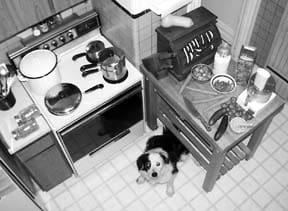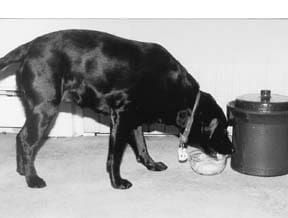There would we be without our microwave ovens, convenience foods, and modern, high-tech food production methods? A lot better off, say some researchers.
One of them is Sally Fallon, founder of the Weston A. Price Nutrition Foundation and author of the ground-breaking cookbook Nourishing Traditions (New Trends Publishing, 1999). According to Fallon, just about everything that has been done to Americas food supply in the last century has been detrimental to the food itself and to those who consume it. The way we grow, harvest, store, and process our grains, fruits, vegetables, oils, meat, poultry, and dairy products is entirely different from methods used by humans around the world for thousands of years.
The result, says Fallon, is an epidemic of modern diseases, including cancer, heart disease, allergies, and auto-immune disorders. It is only by adopting our ancestors farming and food preparation methods, she says, that we can fully meet our nutritional requirements and enjoy perfect health.

Traditional preparation methods increase the digestibility of many foods we share with dogs. These simple steps so dramatically improve the nutritional content of everyday foods that they reduce or eliminate the need for nutritional supplements.
In fact, the food-source nutrients that these techniques release are so easily assimilated that their effects are superior to those of any synthetic or laboratory-produced supplement. Improving the nutritional content of the food we give our dogs can significantly improve their overall health, endurance, skin and coat condition, joint flexibility, strength, digestion, wound healing, reproduction, and immune function.
Time and organization are the main ingredients in these techniques, but quality is a factor, too. Holistic veterinarians agree that todays dogs are adversely affected by industrial and agricultural chemicals and pollutants. Whenever possible, it makes sense to use organically grown, minimally processed, fresh, whole foods.
Any home-prepared diet can be improved without altering its basic ingredients or menus by using the following methods.
Lactic acid fermentation
Vegetables are important to canine health, and although advocates of home-prepared diets debate the quantity of vegetable matter dogs should consume, all agree that vegetables contain essential nutrients that are not provided by other foods.
Unlike animals that evolved on a vegetarian diet, dogs lack the ability to break down cellulose, a carbohydrate consisting of linked glucose units in plant cell walls. One way to help dogs digest vegetables is to puree them. Blenders and food processors make this task easy, and pureed root vegetables like carrots and parsnips, leafy herbs such as parsley, and grasses like wheat grass or barley grass can be added to every meal with good results.
There is another way to improve the digestibility of vegetables, and a growing body of research indicates that this method both prevents and helps cure cancer and other serious illnesses. Lactic acid fermentation is one of the simplest and oldest methods of food preservation.
There are two kinds of lactic acid. One is found in the blood, muscle tissue, and stomach; the other is produced by bacteria. During active exercise, pyruvic acid, a compound derived from carbohydrates, breaks down into lactic acid, which can accumulate in the muscles and cause cramps. Lactic acid consumed in foods such as yogurt and naturally fermented vegetables does not have this effect. It actually helps remove the harmful lactic acid from muscles.
Lactic acid that is generated through fermentation produces vitamin C, vitamin B12, enzymes that support metabolic activity, choline (which balances and nourishes the blood), and acetylcholine, which tones the nerves, calms the mind, and improves sleep patterns. Lactic acid is also a chemical repressor that fights cancer cells without harming healthy cells.
As William L. Fischer explains in his book How to Fight Cancer and Win (Alive Books), unpasteurized sauerkraut and other fermented vegetables are living foods that improve bowel health and digestion, maintain beneficial intestinal flora, help eliminate harmful bacteria, improve the assimilation of nutrients, and enhance healing.
To make lacto-fermented vegetables, you dont need special equipment, although a plastic Japanese salad press or ceramic German pickle crock simplifies the effort. You can do it in a glass or ceramic bowl using a weighted plate as a press. The basic ingredients are vegetables, a pinch of salt, a few optional herbs, and time.
Cucumbers, the fastest to prepare, are ready in about two hours. Carrots and other root vegetables take a couple of days if they are sliced rather than shredded and a week or more if prepared in a large ceramic crock. You may try this technique on your pet’s behalf, but once you taste the results, lacto-fermented vegetables may become part of your own daily diet. The vegetables can be added to salads, served as side dishes, or used in recipes that call for raw vegetables.
As with any new food, introduce fermented vegetables gently and in small quantities. Many dogs love them at first bite, but if your dog needs coaxing, mix a tiny amount with her regular food and whatever oil you normally add, such as flax seed, coconut, or cod liver oil.
Some pet nutritionists recommend that vegetables make up as much as 20 to 25 percent of a dog’s diet, while those who follow the prey model, in which vegetables represent the partly digested contents of a prey animal’s digestive tract, use much smaller amounts. Whatever vegetables you now feed can be replaced with a slightly smaller amount, such as 10 to 15 percent less by volume, of lacto-fermented fare. Fermentation and pressing condense the vegetables and concentrate their nutrients. The resulting liquid, which looks like water but is really the vegetable’s juice, is a rich source of lactic acid and other nutrients. It can be added in small amounts, such as 1 or 2 tablespoons at a time, to your pets food and drinking water.
Vegetables are ”done” when they taste tangy and feel slightly soft. They keep in the refrigerator for several weeks, especially if stored in plastic bags from which you press the air before sealing, or store them in glass jars with their juice.
For best results, use an unrefined sea salt such as Eden, Lima, or Celtic Sea Salt, all of which are sold in health food stores. These salts, which are manufactured in France by traditional methods, are gray in color, feel moist to the touch, and contain all of the minerals and trace elements found in unpolluted sea water.
Wash vegetables thoroughly, but do not peel organically grown produce except for thick-skinned cucumbers; if the vegetables are commercially grown, reduce pesticide residues by washing well, removing outer leaves, or peeling. Then slice with a knife, shred with a grater, puree, or slice/shred with a food processor, discarding any tough stems or damaged portions. Use only glass, ceramic, stainless steel, or plastic pressing materials, not aluminum, tin, or copper. Keep all utensils meticulously clean.
Want a preview? Too busy to make your own? Some health food stores carry lacto-fermented vegetables, including unpasteurized sauerkraut.
Making grains digestible
Although dogs are not designed to eat cooked food, they cannot digest raw grain, either. Pet nutritionists agree that the only grain that dogs can fully utilize has been predigested, such as by a prey animal’s digestive organs. Cooked grains are more digestible than raw grains, but cooking does not digest grains. Microwave cooking, cooking in a pressure cooker, and the high heat and pressure used in extrusion processing (the method used to produce most commercial kibble) alter the protein molecules and fragile oils in grains.
In traditional cultures, grain was never used in its dormant state. Raw grain contains enzyme inhibitors that prevent sprouting until the grain absorbs enough moisture and warmth to support life. Lacking these conditions, grain remains inert.
In the industrial West, grain is taken from field to storage in a single day. This is very different from traditional methods, in which harvested grain was left in the field for days or weeks, during which rain and sunlight provided the conditions needed for germination. Partly germinated grain was stored whole, ground just before use, and soaked overnight before cooking. Gruels and porridges made from the grain were cooked slowly over gentle heat, and breads made from it were allowed to ferment for days before baking. All of these steps release vitamins, amino acids, and other nutrients while removing chemicals that interfere with digestion.
Soaking removes phytic acid, an organic acid in untreated grain which combines with calcium, magnesium, copper, iron, and zinc in the intestinal tract, blocking their absorption. According to Sally Fallon, this is why a diet high in whole grains can lead to serious mineral deficiencies and bone loss. You can prevent this adverse effect with overnight soaking in warm water, which, in addition to destroying phytates, neutralizes the enzyme inhibitors present in all grains, increases the production of beneficial enzymes, helps break down gluten (a difficult-to-digest protein found in most grains), and makes grains less likely to cause allergic reactions.
Unlocking nutrients
The process of germination or sprouting changes grains into living foods that are rich in vitamins, trace minerals, the carbohydrate-digesting enzyme amylase, amino acids, and other nutrients. Before-and-after measurements show as much as 25 times more vitamin K and 12 times more carotene in grain after it has sprouted. B-complex vitamins such as pantothenic acid typically increase up to 200 percent, vitamin B12 by over 500 percent, pyridoxine by 600 percent, and riboflavin by nearly 150 percent.
Use organically raised wheat, rye, spelt, kamut, barley, oats, millet, buckwheat, or other grains from a health food store, macrobiotic supply company, or sprout catalog. Rice is the only popular grain for which this process is not recommended.
Soak ½ to 1 cup grain in a wide-mouth quart jar of water to which you have added 10 drops of liquid grapefruit seed extract, an all-purpose disinfectant. Soak the grain 10 to 12 hours or overnight. For increased mineral content, add a pinch of powdered or liquid kelp to the soak water. H
ealth food stores sell plastic sprouting lids for wide-mouth quart jars, or you can fashion a sprouting lid with cheesecloth and a rubber band. Sprouting lid in place, drain the jar well, then lay it on its side in a warm place away from direct sunlight. Ideal sprouting temperatures are between 70° and 80° Fahrenheit.
After 24 to 36 hours, you will see small white roots emerge from the grain. If you dont see this growth on almost every seed by the second day, your grain is not viable and should be discarded. Assuming that its sprouting, let it grow another day, then puree the grain in a blender or food processor.
Add a tablespoon of raw honey (a source of carbohydrate-digesting amylase) and/or ¼ teaspoon of an enzyme powder containing amylase and let the mash stand at room temperature for an hour or two before refrigerating. This gives the amylase a chance to work, further breaking down and predigesting the grain.
To introduce predigested grain to your dog, start with 1 teaspoon per 10 pounds of body weight every other day and gradually increase the amount as desired.
Cooking grains
Many popular diets for dogs include large or small amounts of cooked grain. The nutritional content of any cooked grain can be improved by first soaking it in warm, filtered water and whey. For best results, soak 1 cup grain such as whole wheat, rolled or cracked oats, or a coarsely ground blend of wheat, millet, short-grain rice, barley, and oats, in 1 cup water plus 2 tablespoons liquid whey for at least 6 hours or up to 24 hours. Some grains, like rye, may need additional water and soaking time for complete hydration. The ancient grains teff and amaranth are best soaked for 24 hours.
To make a traditional porridge, add the soaked grain to 1 cup boiling water or stock, lower heat, cover, and simmer for 5 to 10 minutes. Soaking significantly reduces the cooking time of whole grains.
To make a simple whole-grain casserole, Sally Fallon recommends combining 2 cups sprouting grain with 3 cups beef or chicken stock. Bring to a boil and skim. Add 1 teaspoon sea salt and ½ teaspoon each dried thyme, rosemary, and crushed green peppercorns. Boil vigorously until the liquid is reduced to the level of the grain. Transfer to a 250°F oven and bake for approximately 4 hours, or until the grain is tender.
Add digestive enzyme powder according to label directions when feeding cooked grain to help compensate for the enzymes destroyed by cooking.
Whole rice and millet contain lower amounts of phytates than other grains, and they are gluten-free, which makes them easier to digest even without presoaking. However, these grains should be cooked very slowly over low heat in a high-mineral, gelatinous broth to facilitate digestion.
Corn is widely used in commercial pet foods because it is inexpensive. It is also notoriously difficult for dogs to digest. In traditional cultures that utilized corn or maize, it was always soaked in lime water. Soaking in lime water releases the vitamin B3 in corn, which otherwise remains bound up, and it improves the amino acid quality of proteins in the corns germ. Soaking also destroys corns enzyme inhibitors.
To make lime water, place 1 inch of dolomite powder (sold as a supplement in health food stores) in a half-gallon (2-quart) glass jar. Fill the jar with filtered water, cover tightly, shake well, and let stand overnight. The resulting clear liquid will be lime water, which does not require refrigeration. To use, carefully pour off what you need without disturbing the settled powder. To replenish the jar, top it with filtered water, cover, and shake well. Also With This Article Click here to view “Feed Your Dog Vegetables” Click here to view “Home Prepared Dog Food Recipes”






